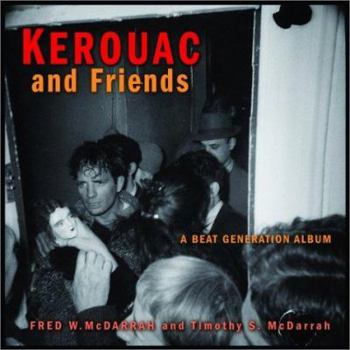Kerouac and Friends: A Beat Generation Album
Select Format
Select Condition 
Book Overview
Renowned photographer Fred McDarrah captures the Beats in the midst of their rise to acclaim. His 100 shots of Kerouac, Ginsberg, Burroughs, and others partying in cheap downtown Manhattan apartments, socializing at Grove Press book parties, and hunching over their typewriters are joined by writings from a diverse and illuminating raft of sources. Jack Kerouac contributes a list of activities necessary for writing success ("1. Scribbled secret notebooks, and wild typewritten pages, for yr own joy"), Diana Trilling shares her thoughts on her fears of and for husband's former student, Allen Ginsberg, and Mad magazine sends up the young men and women who took up the beat lifestyle Kerouac and friends made famous. Kerouac and Friends is a fresh and surprising look at the young men and women who would come to define the last major epoch in American literature. "A lot of great stuff here about those Abominable Snowmen of modern poetry, the Beats."--Lawrence Ferlinghetti "Not merelya marvelous nostalgia trip. It also illuminates an important period in American culture. First rate!"--Michael Harrington
Format:Paperback
Language:English
ISBN:1560254807
ISBN13:9781560254805
Release Date:January 2003
Publisher:Da Capo Press
Length:400 Pages
Weight:1.80 lbs.
Dimensions:0.6" x 8.5" x 8.5"
Customer Reviews
1 rating
Portrait of an Age
Published by Thriftbooks.com User , 17 years ago
Anyone interested in Jack Kerouac and the Beat Generation will be enchanted by "Kerouac and Friends: A Beat Generation Album" by father and son writing team Fred W. McDarrah and Timothy S. McDarrah. As picture editor of the Village Voice for more than forty years, Fred McDarrah was friendly with all the Beats in their heyday and went to all their parties and readings, always with his camera in hand. On intimate terms with many of them, McDarrah didn't consider himself a Beat because he always had a paying job. In subsequent years, he kept in touch with Allen Ginsberg, Norman Mailer, Amiri Baraka, Ted Joans, and others, and in 1984, twenty-five years after Kerouac's "On the Road" was published, numerous friends and his sons Timothy and Patrick convinced him to publish a book with all his old photos. The pictures alone are worth the price of admission, but to give the book its substance, the McDarrahs have put together a compendium of twenty-eight of the best articles, both pro and con, about the Beat scene, from the original essay by John Clellon Holmes defining "Beat," through articles by Kenneth Rexroth, Seymour Krim, Diana Trilling, Fred McDarrah, and Jack Kerouac in his essay "The Last Word," concluding with Jack McClintock's sad finale, "This Is How the Ride Ends." Reading these seminal articles about a literary phenomenon that divided American literary critics puts the reader in touch with the controversial vibes of the times. This is the meat of the book, but it wouldn't be nearly so appetizing without the sauce provided by McDarrah's intimate pictures of the participants, youthful and sincere, in their Greenwich Village pads and hangouts, cafes and jazz joints, auditoriums and back alleys. The book concludes with a twenty-five-page section of brief biographical sketches of everyone identified in the photographs and the writers of the articles and is worth reading in its entirety, from Daisy Aldan, editor, translator and publisher of the poets and painters of the New York School, to Louis Zukofsky, noted New York poet born of Russian immigrant parents. Reading the sketches is like eating a light dessert after a fine meal. For connoisseurs of the Beats, "Kerouac and Friends" is indeed a feast. The book is truly a portrait of an age.






